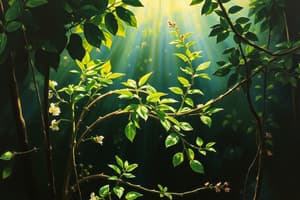Podcast
Questions and Answers
Photosynthesis involves plants absorbing oxygen and converting it into carbon dioxide for energy.
Photosynthesis involves plants absorbing oxygen and converting it into carbon dioxide for energy.
False (B)
The term 'photosynthesis' literally means 'dark construction,' referring to the absence of light needed for plants to create energy.
The term 'photosynthesis' literally means 'dark construction,' referring to the absence of light needed for plants to create energy.
False (B)
Chloroplasts, which contain chlorophyll, are located in the roots of plants to maximize water absorption for photosynthesis.
Chloroplasts, which contain chlorophyll, are located in the roots of plants to maximize water absorption for photosynthesis.
False (B)
Stomata are responsible for absorbing water from the soil and transporting it to the leaves for photosynthesis.
Stomata are responsible for absorbing water from the soil and transporting it to the leaves for photosynthesis.
While land plants are crucial, ocean plants like phytoplankton contribute a relatively small fraction, approximately 5%, of the Earth's total oxygen production.
While land plants are crucial, ocean plants like phytoplankton contribute a relatively small fraction, approximately 5%, of the Earth's total oxygen production.
Flashcards
Photosynthesis
Photosynthesis
The process where plants create their own food using light.
Photosynthesis Needs
Photosynthesis Needs
Sunlight, water, and carbon dioxide.
Stomata
Stomata
Tiny pores in leaves that absorb carbon dioxide.
Photosynthesis Products
Photosynthesis Products
Signup and view all the flashcards
Photosynthesis Importance
Photosynthesis Importance
Signup and view all the flashcards
Study Notes
- Photosynthesis enables the production of food by plants
- The term 'photo' means light, while 'synthesis' means to put together
- Sunlight is converted into chemical energy through photosynthesis, supporting plant activities like growth and seed production
Requirements for Photosynthesis
- Plants require sunlight, water, and carbon dioxide to carry out photosynthesis
- Starches and sugars are produced, and oxygen is released as a byproduct
How Photosynthesis Works
- Chloroplasts in leaves and green parts of plants absorb sunlight
- Chloroplasts contain chlorophyll, which gives plants their green color and captures sunlight energy
- Carbon dioxide is absorbed from the air through stomata, which are tiny pores in the leaves
- Water and nutrients are absorbed through the roots, then transported to the leaves
Glucose and Oxygen Production
- Glucose, a type of sugar that fuels plant growth, is created when sunlight and water combine with carbon dioxide inside the leaves
- Carbon dioxide transforms into oxygen during photosynthesis, which is then released back into the atmosphere through stomata
Importance of Photosynthesis
- The majority of Earth's oxygen is produced by plants through photosynthesis
- Phytoplankton and other ocean plants generate up to 70% of the Earth's oxygen
- Plants depend on the sugars made during photosynthesis for development, good health, and the creation of flowers and fruits
Sugars and Human Life
- Plants provide energy to humans and animals that cannot produce their own food from the sunlight
- For humans and animals to survive, photosynthesis is essential because it converts water, light, and carbon dioxide into sugars and oxygen
Studying That Suits You
Use AI to generate personalized quizzes and flashcards to suit your learning preferences.




